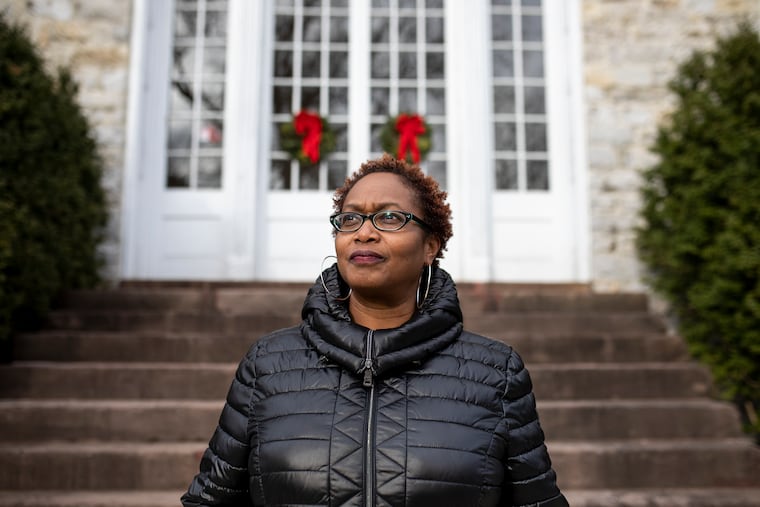This award-winning Dickinson professor is rethinking how Black artists show death
Jerry Philogene, an arts scholar who recently won an Andy Warhol Foundation Arts Writer grant, explains how even in death, Haitian artists depict new possibilities.

When Jerry Philogene studies death, she doesn’t just simply look at the moment when life ends. Philogene, an arts scholar and American Studies professor at Dickinson College in Carlisle, Pa., looks at not only how artists show death as part of life, but also how Black people experience that morbidity that surrounds them. She draws on a mix of knowledge from sociology to vodou iconography.
Philogene points to the work of Harvard sociologist Orlando Patterson, who coined the term “social death” to describe how society did not extend humanity to enslaved people. Today, Black people are still fighting for humanity, she said.
She first began her line of research after the catastrophic 2010 earthquake in Haiti.
“Basically, the camera would just pan across these multiple bodies,” Philogene recalled. “And I thought, ‘Wow, like, how incredibly disrespectful,’ but also there was a sense of displacement as if these individuals were not human. And then I started also thinking about [Hurricane] Katrina, the same issue — how these bodies that were dying, dead, or in the process of death, were again seen as just these objects.”
In this state without humanity, Philogene explained, Black people “have no soul, they have no agency, they have no authority, they exist in this liminal vacuum space.”
“We live in that kind of condition. But how do we also find that moment, that condition as empowering?” asked Philogene, who considers George Floyd’s killing a moment of social death. “How can we, even in this moment of death and trauma, think about how we live [and] the possibility of life?”
Philogene won an Andy Warhol Foundation Arts Writer grant last month. Her $50,000 award will support her forthcoming book, The Socially Dead and Improbable Citizen: Theorizing Visual Transformations of Haitian Citizenship.
The book will explore how artists of the Haitian diaspora, like Jean-Michel Basquiat and Myrlande Constant, explore depictions of death and memorial. It will also trace the influence of Haitian traditions on other Black artists, like Kerry James Marshall and Ebony Patterson. The Inquirer spoke to Philogene about her research and how she’s rethinking death and how we see it. This interview has been edited and condensed for length and clarity.
Could you speak about how vodou theology and its perspectives on death inform your research?
There are these, what we call “lwa,” the spirits that guide you in life but also guide you through the process of death. And one of the main lwa of Ghede, which is the lwa of death, is Baron Samedi, who is the person who kind of sits at the crossroads.
He’s mischievous. He is funny. He is proud, but he’s also someone who guides you and helps you live in death. So even if your body is no longer, your spirit is still alive. So for vodouists, those who believe and practice vodou and honor Baron Samedi, he allows you to live even if you’re living in misery.
There are other lwas, but he is the main one who allows you to think about how do you live in the space of death and live in a kind of, I don’t want to say celebratory fashion, but in a fashion that renders you human, that gives you humanity.
You speak about social death and then also the condition that Black folk with enslaved ancestors around the diaspora are experiencing today. How are you conceptualizing the way that Black artists are looking at this feeling of precarity you described, looking at this feeling of living within death?
In a variety of different ways. So one of the artists I look at, his name is Jean-Ulrick Désert. He is a Haitian artist who lives in Germany. And there’s one piece in particular that I look at. It is this beautiful wall installation that is covered with 750 stars and planets. It’s the stars and how they were aligned exactly at the moment in which the earthquake happened. So, in a conceptual fashion, the piece is evoking this moment of death. But there is something incredibly beautiful about the piece, because it is this rich velvet background. It [has] these small embossed stars that have the image of Josephine Baker stamped onto the image.
This wall installation memorializes these bodies, these bodies that were at one time just left on the ground to bake in the hot sun of Haiti. In this moment of impossible pain and possible death, there is something that rises out of those ruins.
You’re thinking through what it means to be human in your work. Where are you at with that now?
So I’m still trying to figure that out. But for me, in the book, I am arguing that humanity, our humanity, as Black people is one that we take, is one that we demand. And it’s one that is our right.
Has the pandemic made you think about your work differently? And if so, how so?
In one sense, it’s made me appreciate the fact that we actually see what America really is, it has shown us that deep within the ground, there is all this discontent and hatred.
But what is more exciting for me is the way that Black people, people of color, allies have fought against some of that. We’ve seen the hatred and the discontent, the lies, but we also see the moments of empowerment, of agency, of fighting. for This is, again, what my book is about: How can we make this livable?